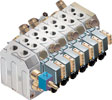
A cinch for truck mounted and marine cranes.
The HC-MV99 is a proportional load sensing control valve (LSCV) developed by Hydrocontrol Spa. Specifically designed for lifting applications, it meets all the required specifications to ensure the best control of dynamically complex machinery and has the advanced features found in proportional control valves today.

The valve is available in an inlet-compensated version only and also in an all-section compensated version, to allow full control on simultaneous operations. It can easily be matched to circuits with fixed or variable displacement pumps.
Each section of the valve is equipped with auxiliary valves on the ports (shock-proofing, cavitation-proofing and combined piloted valves). Manual, hydraulic, electric ON-OFF and proportional electric actuators are available.
The valve's basic construction principle and special inner duct configuration enable users to build circuits and come up with a range of functions not achievable by many LSCVs. For these reasons, the HC-MV99 is fitted today to a variety of machines. This control valve can be found not only in truck mounted cranes, marine cranes, timber cranes and loaders, but also in refuse compactors, hook loaders, medium-sized excavators and concrete pumps.
Truck mounted cranes
This is the application for which HCMV99 was specifically designed. The European market of truck mounted cranes has been using proportional LSCVs for several years. Truck mounted cranes are extremely complex machines in terms of control: very wide ranges, heavy loads, high elasticity of the structural steelwork will trigger a number of dynamic and inertial effects which are very hard to control.
Once an LSCV system has been optimised, it allows very accurate capacity and performance control independent of load; above all, individual element local compensation enables such systems to obtain synchronous simultaneous movements.
On the downside, it may not be so easy to develop an LS system: the various control valve compensators are oscillating systems, which may sometimes trigger unwanted resonance effects, amplified by dynamic boom swinging. Hydrocontrol has developed an extensive range of spools to both provide a wide selection of capacities at ports (with different capacities for ports A and ports B) and to control back-pressures, instability, and load carrying.
Proportional electric actuation is the latest breakthrough. The number of radio-controlled machines is constantly on the increase; demand for remote control is increasing because it enables a single operator to carry out the entire loading and unloading operation; additionally, the operator may remain at a distance from the vehicle, next to the load, to be able to better monitor the trickiest handling operations.
The HCMV99 can be interfaced with the products from leading radio control equipment manufacturers.
The valve is also equipped with all the auxiliary devices normally requested by crane manufacturers: load-limiting hydraulic locks, an electronic device identifying the spool operating direction and a safety valve for flow rate dumping are available.
These devices are interfaced with the crane safety system, which is operated when a certain position is reached likely to affect the static balance of the vehicle.
In this situation, the hydraulic locks are high pressure piloted to act on special pistons and prevent the operator from moving the spools in any direction which would worsen the machine balance. The operator can only move from this position to restore the initial safety conditions.
In the electronic version, an LVDT transducer is fitted to the LSCV to detect the spool operating direction. This information is processed by an electronic controller. In a dangerous situation, the controller checks the machine movement direction. If the new commands do not tend to restore the crane safety condition, the electric dumping valve located on the LSCV inlet manifold is de-energised and the control valve operation is totally inhibited. Only if the next command results in an approved operation can the dumping valve be reset to resume work.
The discharge valve (be it electrically piloted or hydraulically piloted) characteristically acts not on the LS signal like most other LSCVs but on the full flow rate. This means that, when it is switched off, the entire flow is conveyed to the tank with very limited pressure drop. This actively contributes to safety, because it can totally inhibit the control valve operation, which is not the case on all LSCVs.
For more information contact Sean Erasmus, Fluid Power Components, +27 (0)11 663 4800, [email protected], www.fluidpc.co.za

© Technews Publishing (Pty) Ltd | All Rights Reserved